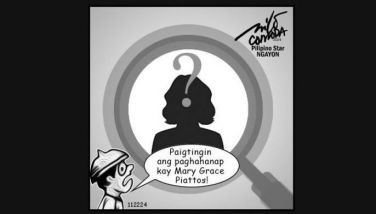Fresh pine scent is gone!

BAGUIO CITY, Philippines – The view from the veranda of the Baguio Country Club allows me to imagine the City of Pines as it was in my youth. The big pine trees are still there and the mountains in the distance still have some greenery. And if I kept myself within the vicinity of the country club and Camp John Hay, I can still savor the fresh mountain air that any lowlander craves for in a Baguio vacation.
The weather had been just marvelous. It was drizzling when we drove up the Marcos Highway last Tuesday, but it had been postcard pretty since… a blue sky with nice cumulous clouds caressing the not so distant mountains. The temperature is just cold enough to enjoy natural air conditioned comfort. Indeed, this is the best time of the year to visit Baguio.
I still remember the first time I went up to Baguio with my Dad when I was seven years old. We took the train from Tutuban all the way up to Damortis in La Union. From there we were taken up the zigzag Kennon Road by a black Chevy Bel Air. We stayed at the Casa Vallejo. I am glad to see that the hotel is still around, recently renovated just enough so as not to lose its old world charm.
Casa Vallejo now boasts of a marvelous restaurant called Hill Station and I took my visiting sister and her American husband there for lunch last Wednesday. The cuisine did not disappoint us. But getting there and finding a parking space can be challenging. Baguio, after all, is no longer that nice slow paced vacation place but a terribly bustling urban center that’s just bursting at the seams.
Driving around Baguio is no longer the joy it once was. Like Metro Manila, there seems to be too many vehicles, too many people in the same limited space. SM City nestles in the hill where the legendary Pines Hotel used to be, and it is teeming with as many people as in any SM mall in Metro Manila. We were lucky to get the last remaining parking space in the mall basement.
It was early evening so we decided to walk with the crowd down the SM hill to Session Road below. It was the week after the Christmas break… but I am told this is normal Baguio rush hour. The horde of vacationing lowlanders have largely gone back home. Baguio is simply suffering a serious population explosion.
No wonder they also have a vehicle coding system similar to what we have in Metro Manila. Theirs is even stricter in the sense that it is 7am to 7pm with no windows during the mid-day. But it only covers a rectangular shaped central business area that centers on Session Road and Burnham Park. Walking down and up Session Road is not fun anymore. The smell of diesel has replaced the smell of pine.
I had not been to Baguio in a very long time. The last time I was here the SM mall was not even up. I found no good reason to go up to Baguio because of all the bad reviews. I kept on hearing the city has changed and not for the better. I wanted to preserve in my mind what I remember of Baguio as a kid and as the place where my wife and I had our honeymoon over thirty years ago at about this time of the year.
But my US-based eldest sister was visiting and she had not been to Baguio in 40 years. So we drove up. Going up was no longer the harrowing experience of some recent years when damaged bridges in Pangasinan forced long dusty detours. The NLEX, SCTEX and even the MacArthur Highway were all pleasant to drive, if you can discount the tricycles on the public highway. It was also obvious that the pork barrel funds of some congressmen are being put to good use widening MacArthur Highway in portions of Tarlac and Pangasinan.
But once you get within Baguio city limits, it is as if you didn’t leave Manila, only worse because the traffic jams must be endured over rolling terrain. It also makes you wonder why government is allowing all those buses and jeepneys to spew thick black smoke and get away doing that. It is as if all the good intentions of requiring motor vehicles to be tested for emission before being allowed to register have gone to waste.
Most of Baguio today is far from pretty. The hillsides are teeming with shanties waiting for the next landslide. The hillside slums of Baguio remind you of the favelas of Rio de Janeiro. With another landslide taking more lives in the Compostela Valley in Mindanao, national and local officials should start thinking of disaster mitigation plans in this mountain city before that happens here too.
In fact, I am told, a slide in a garbage dump on the narrow road to the Bencab Museum supposedly claimed six lives not too long ago. As in any city, the local city government must truly have a serious headache handling Baguio’s trash. The city government has reportedly been sued by residents for a writ of kalikasan on account of this failure.
My friend Rick Ramos explains why Baguio seems so unkempt these days. Reacting to a status post I made on my Facebook wall, Rick commented that “Baguio was designed by the Americans as the summer capital for 20,000 persons. Now, its population as of 2007 was placed at 301,000 with only an area of 5,500 hectares. So indeed, it is bursting at the seams.”
He continued: “You are lucky you went there after the New Year with less tourists. We were there after Christmas and traffic was super-bad.” I hate to imagine what super bad means, given what we are experiencing now. I was at a loss on what to show my sister and her American husband. The Baguio they are seeing is nothing to be proud of. I thought maybe they might enjoy the museum set up by Bencab, the national artist, who has made the city his home.
Yes, BenCab’s museum is a must-visit place in Baguio. It saved the day for me. I had something beautiful that’s made by a world class Filipino to show. The national artist has put up an architecturally beautiful building that houses the museum. The more amazing thing is how the artist did this out of his own personal funds.
Bencab also bought surrounding areas and started to reforest the mountains around his property. What you see from the coffee shop of the museum is a view of Baguio as it should be --- green and beautiful. But even here, there are squatter shanties just outside his property line to bring you back to sad reality.
The Bencab museum presents not just the works of the national artist but of many other contemporary artists. The museum showcases the best of Philippine art and it is all because we have a successful artist who has a sense of responsibility to pay back to society and country. He has set up a foundation that runs the museum, provides employment and gives a good impression of us and our culture to our visitors. We saw the motorcade of the American Ambassador driving towards the museum as we were driving back to Baguio city center.
Camp John Hay is now more developed than it used to be. It has lost a bit of its charm as a US military camp with its more evident commercialization. But it is still sufficiently green and with enough pine trees to remind us of the Baguio we knew. But a large building near the main entrance housing call centers reminds us of sheer reality of our times. Hopefully, BCDA carefully manages its development so that what makes Camp John Hay special is not fully lost.
I commiserate with the local officials of Baguio today. They have very serious problems and there aren’t many very good options to take. Daniel Burnham, if he could see Baguio in the afterlife, would likely be very disappointed at what has become of his carefully designed and charming city. I don’t know if we can even get back Baguio’s fresh pine smell again. Baguio’s story is Metro Manila’s story and maybe Metro Cebu as well --- development gone wild. And I don’t know how the development of these cities could be tamed and brought back on track again.
‘Bourne’ in Manila
This is hilarious… from the blogsite of the Professional Heckler.
Online reports say the Hollywood flick ‘Bourne Legacy’ will shoot some scenes in the Philippines including a car chase along Edsa. Good luck to that.
Boo Chanco’s e-mail address is [email protected]. He is also on Twitter @boochanco
- Latest
- Trending





























